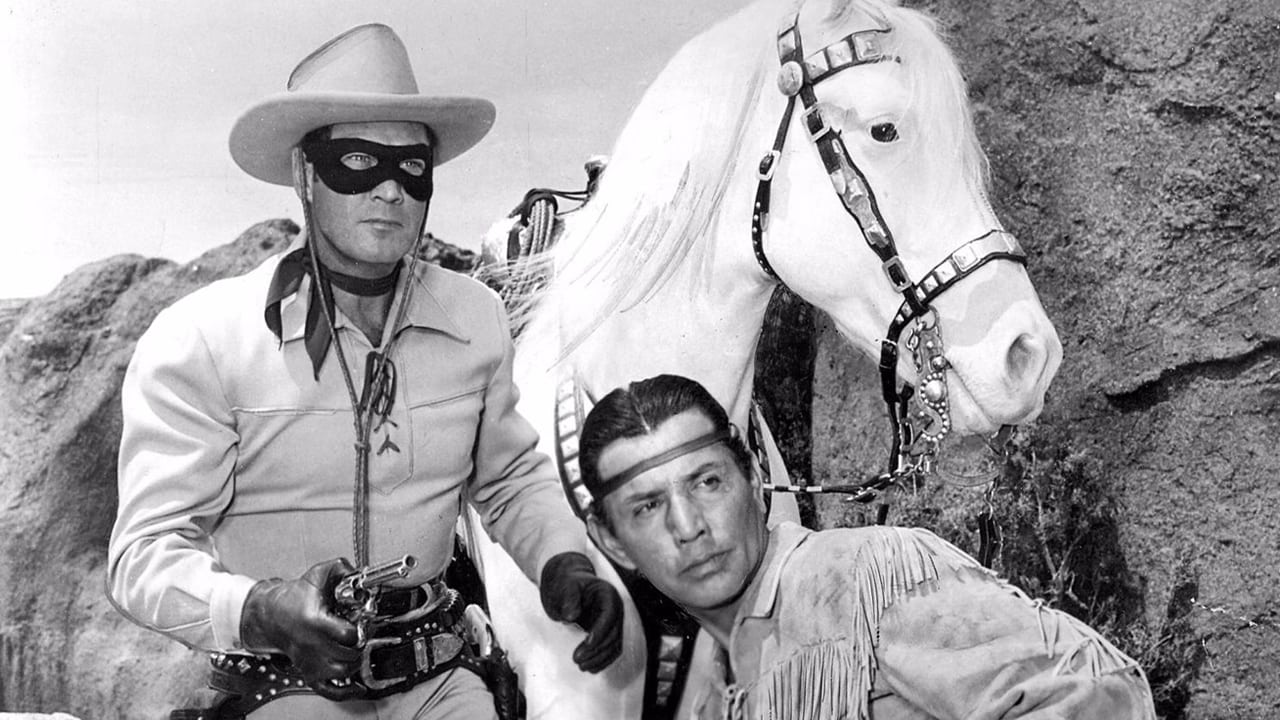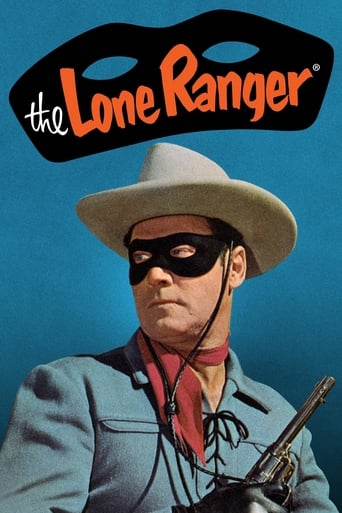



This is How Movies Should Be Made
This movie was so-so. It had it's moments, but wasn't the greatest.
View MoreIt really made me laugh, but for some moments I was tearing up because I could relate so much.
View MoreThe story, direction, characters, and writing/dialogue is akin to taking a tranquilizer shot to the neck, but everything else was so well done.
View MoreI wasn't even born when this series was released in the USA. It took about another decade before British TV networks laid hold of it.In fact, I was fortunate enough to see the very first episode, in which The Lone Ranger was one of a posse who ran into an ambush and got slaughtered. TLR was the only survivor. Although badly wounded, he was saved by a passing Indian called Tonto. I believe he took to wearing a mask in order to hide his true identity for fear of reprisal. But instead he made himself all the more recognisable. Dunno if he wore it in his sleep.This was Saturday teatime staple. The fanfare bugles of William Tell's overture presaged a dash to the telly, food still in hand. Though it very quickly became repetitive, predictable hokum. Nobody ever unmasked him. Nobody ever landed a punch, nobody ever out-shot him. He was a little too good, and just a little too camp in his dress for most kids. Poor Tonto, on the other hand, became his Aunt Sally. He was always getting slugged and tied-up and kidnapped and stuff.And what did he keep calling The Lone Ranger? 'King Savvy' was the general consensus where I lived. It seemed to imply 'the big know-all' in Indian-speak. But is sounded like something else, as if Mr Silverheels had a speech defect. 'Kemosabe'; what the hell's that? A later, and less well-merchandised duo called 'The Range Rider' and 'Dick West' eventually won my vote. This featured a naked-faced Jock Mahoney who got beat-up pretty thoroughly in each episode and was altogether less camp, less super, and more believable.Still; even today I can't hear William Tell's overture without expecting the gallop of hooves and a hearty Hi-Oh Silver.Devine daftness.
View MoreThe Lone Ranger appeared on the ABC network on September 15, 1949 in the first of a three part episode that told the history of the famous masked man of the West. Along with William Boyd's Hopalong Cassidy TV series, which was first telecast on NBC on June 24, 1949, it was among the earliest TV western series. Hopalong Cassidy actually debuted in 1948, when Boyd syndicated his films to NBC. (In 1947, Boyd had bought to the rights to his Hoppy films.)Fran Stiker and George W. Trendle created the Lone Ranger as a local radio program in 1933. It quickly went nationwide and was the cornerstone of the old Mutual Radio network. Ironically, Hopalong Cassidy was also a Mutual radio program.When The Lone Ranger was brought to TV in 1949, many of the radio plays were adapted to the younger medium. As a consequence, many of the earliest episodes show their radio origins with the use of a narrator who links the different scenes together. The Lone Ranger was the biggest hit on the new ABC network in its early years. The first three episodes told the the familiar story of how the Lone Ranger came to be, his connection to Tonto, and the origins of his prize horse Silver. Glenn Strange played the villain Butch Cavandish in these episodes. The Lone Ranger was also one of the earliest shows to film mostly outdoors. Starting in 1956, the Wrather Company began filming the program in color. The Cisco Kid, starring Duncan Renaldo and Leo Carrillo had been filmed in color since its first aired in 1950. Jack Wrather, however, was more concerned about the competition to his kid's show from the new adult westerns that had began to appear on TV. When the Lone Ranger appeared, The New York Times critic Jack Gould ripped the show, as "just another Western, and not a notably good one at that." Gould considered the first three episodes manipulative, mostly because of the cliffhanger endings of the first two episodes. The New York Times writer accused everyone associated with the program of keeping children "emotionally hopped upped." As a result of his criticisms, the cliffhanger type endings were never used after the first two episodes. Gould, however, had been suffering from a misunderstanding. The show had never intended to be broadcast as a serial despite the serial background of its star Clayton Moore.In 1952, B-film actor John Hart replaced Clayton Moore. Moore had threatened to quit after 1950. He was being paid only $500 an episode for his hit show, and wanted a substantial raise. Audiences rejected Hart in the role, and after 36 episodes Moore was back atop Silver. The Lone Ranger was the first Western Hit on TV.The series was filmed in both Utah and in California.
View MoreIam not sure if discussing the television series is exactly where the comments should be drawn to,however it is on the television where the The Lone Ranger really made a name for himself.Iam not even referring to the original radio broadcasts of this masked rider of the plains,Iam though referring to a point where in a little boy, about 9 or 10 years old,I was to see the movie,"The Lone Ranger"and never forgot it.I can recall that I was on a line or we were moving toward the Paramount Theater-the theater was located in the theater district,if I remember correctly.It was directly across,going East to West from the building that has the ball that drops on New Years Eve-This is of course if anybody doesn't know, New York City.High Above the street on the roof tops there was a time and maybe even still today huge billboards would advertise what was being shown and so on.It was at that point in time that I looked up and was never more impressed as I was when I looked at that billboard to see The Lone Ranger across the roof tops-It was great-It made an impression and was never forgotten.That day we went to see The Lone Ranger-It was the story of how the Lone Ranger was born-The terrible ambush that the Texas Rangers rode into and the subsequent rebirth of one of its fallen heroes.It was in this film we learn that The Lone Ranger will not shoot to kill but to injure so as to let the law be the judge.That type of thinking is so worthwhile that we might be good to learn something from history.This is where we learn that Tonto discovers the fallen Ranger and upon seeing the symbol of the boyhood friendship that The Lone Ranger established years earlier when he as a younger person came to the aide of a injured young person in Tonto-For the aide given, Tonto gave to his faithful friend, a symbol of his thanks which now was part of a necklace that Tonto recognized.Tonto said,"you are Kemosabe".The Lone Ranger said,"kemo-sabe,that is familiar?Then Tonto tells the story of this "trusty scout"(the meaning of Kemosabe)I think the Lone Ranger is one of the true heroes of the silver screen and one of the great heroes of television.It should also be stated that these very respected individuals Clayton Moore and Jay Silverheels sought to live there lives according to the legend of The Lone Ranger-It may very well be that there is an inspiring story in the story of the Lone Ranger and his faithful companion Tonto.I myself was so pleased by the ability to find and buy the DVDs, that I stayed up all a Saturday morning and watched The many episodes now available.Long Live The Lone Ranger and His faithful companion Tonto-Hi-Ho Silver-
View MoreLooking back on `The Lone Ranger' TV series as an adult is a strange experience. Watching episodes through an adult's eyes alerted me to flaws I didn't notice when I was a kid: the acting was sometimes on the B-movie level. The stories tended to be repetitive and simplistic. The Native Americans were generally played by Caucasian or Hispanic or Italian-American actors. The `outdoor' exteriors in a lot of episodes were obviously indoor sets. But there is a spirit and an energy to the show that you can't deny.Most of the credit for the show's success goes to its leads, Clayton Moore and Jay Silverheels. They became the Lone Ranger and Tonto, lived the roles as no other actors before or since. Moore, in particular, knew the Ranger was presented as a hero and an example to children, and from what I've heard, he tried his best to live up to that. He made the Ranger a fair and just man, someone who didn't judge, who gave people the benefit of the doubt, but acted correctly when the time was right. He used violence only as a last resort. He was a symbol of honor and integrity, the kind of person I wish I could be.As for Tonto... It occurs to me nowadays how great an actor Jay Silverheels was. Critics of the show always want to use Tonto as the stereotypical ignorant savage, but you have to look at all the things Tonto does. Tonto tracks, takes care of the Ranger when he's wounded, spies out information - you can tell from the expressions on Silverheels' face that there's a lot more going on inside Tonto's head than he lets on. Don't let the broken English fool you!The thing that really impresses me about `The Lone Ranger' now is how much of a partnership these two characters have. Tonto is not the Ranger's subordinate - they are friends, equals in their adventures. That, as much as any lesson taught in any episode, is what draws me back to the series after so many years: a tried and true friendship.Oh, if only the Lone Ranger could ride again.
View More